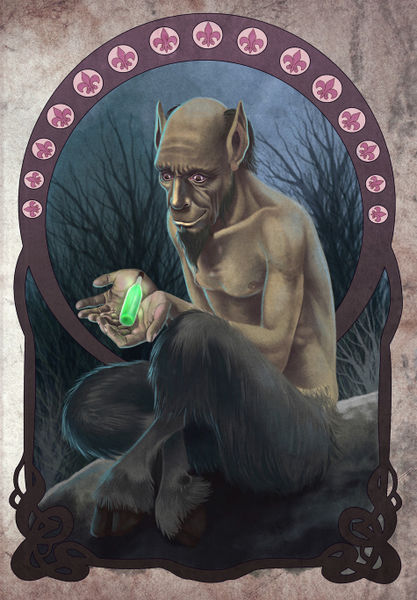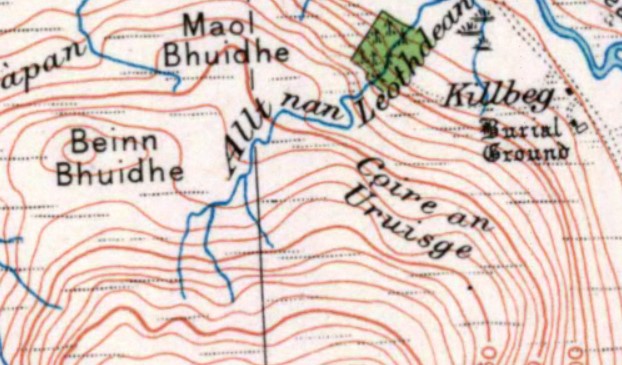Ma nochdas ainm ‘gnè ainmhidh’ air mapa oifigeil, feumaidh gu bheil e fìor is creideasach … no an fheum …? / If an ‘animal species’ is named on an official map, it must surely be a biological reality …. mustn’t it?
An t-Ùraisg – Mac-meanmnach no Fìor?
Tha e na shamhla dhen lagachadh ann an dùthchas is cultar nan Gàidheal, agus nan Albannach san fharsaingeachd, gu bheil mòran nar measg an-diugh nach eil eòlach air an ùraisg (no ùruisg). ’S e a th’ ann ach creutair a tha, no a bha, beò (mura robh e gu tur mac-meanmnach) ann an ceàrnaidhean uaigneach, iomallach dhen Ghàidhealtachd. Tha faclair Dwelly (stèidhichte air seann fhaclair Armstrong) ag innse dhuinn gun robh e na chreutair a ghabhas a-steach buadhan mac an duine agus buadhan os-nàdarrach. Tha na h-aithrisean a th’ againn air na h-ùraisgean ag innse dhuinne gun robh iad air am fuadachadh às na h-àiteachan san robh iad uaireigin a’ fuireach.

Tha iad, ge-tà, air na mapaichean againn, mar gur e ainmhidhean dùthchasach a th’ annta. Mar eisimpleir, air cladach a deas Loch Ceiteirein anns na Tròisichean, eadar Bealach nam Bò agus Ceann an Fhèidh, tha Coire nan Ùruisgean far am biodh na creutairean sin a’ tighinn cruinn còmhla aig amannan. Nas fhaide tuath, faisg air t-Sàilean ann am Muile, tha Coire an Ùruisge. Beagan deas air sin, ann an ceann a deas Mhuile, tha Sloc an Ùruisge, agus tha àite leis an aon ainm ann an Tiriodh. Timcheall Ghleann Urchaidh, bha am facal boireanta oir an sin tha Eas na h-Ùruisg faisg air Taigh an Droma, agus Clach na h-Ùruisg ann an Abhainn Urchaidh. Ann an Carmina Gadelica, tha Alasdair MacIlleMhìcheil a’ toirt dhuinn cunntas de Gleann na h-Ùraisg deas air an Òban, far nach rachadh eadhon ‘daoine treuna’ air an oidhche, agus Coire na h-Ùraisg ann an Cuiltheann an Eilein Sgitheanaich.

Coire nan Ùruisgean (‘na’ should be ‘nan’) on the shores of Loch Katrine, The Trossachs. Detail from OS Six-inch map pub. 1901.
Reproduced with the permission of the National Library of Scotland.
Tha cuid de sgoilearan a’ cumail a-mach gur e ‘uisge’ an dàrna eileamaid ann an ainm a’ chreutair, agus tha na ceanglaichean a th’ aca do dh’uillt is aibhnichean gu math aithnichte. Bha cuid dhiubh air an aithneachadh gu pearsanta, le ainmean orra, agus tha trì-deug dhiubh air an ainmeachadh ann an rann à Bràghaid Albainn. B’ e fear dhiubh Padarlan no Padarlaidh, a th’ air a chuimhneachadh ann an Allt Coire Phadarlaidh siar air Feàrnan air cladach a tuath Locha Tatha. Tha naidheachd ann mun dòigh a chuir tuathanach às an dùthaich e, le bhith a’ cur a mhic fo bhruid.
Shaoileadh cuid gur e Padarlan an aon ùraisg a th’ air a chomharrachadh gu pearsanta ann an ainmean-àite na Gàidhealtachd, ach bidh feadhainn ann an Obar Pheallaidh a’ cur an aghaidh sin, oir tha iad dhen bheachd gu bheil am baile a’ faighinn ainm bho ùraisg air an robh ‘Peallaidh an Spuit’ a bha a’ fuireach faisg air an eas as àirde san allt a tha a’ sruthadh tron bhaile.
Fada tuath air Siorrachd Pheairt, bhathar ag ràdh gun robh dithis ùraisgean beò faisg air eas air Allt a’ Pholl-choire, deas air Poll Iù ann an Ros an Iar. ’S Crotachan Liobastan a bh’ air fear dhiubh, agus Ciuthach Caogach a bh’ air an fhear eile. ’S iongantach gun robh iad bòidheach don t-sùil! Tha sgeulachd ann, coltach ri sgeulachdan à sgìrean eile, gun d’ fhuair boireannach cuidhteas iad le foill, agus nach fhacas bhon uair sin iad.
’S e Bràghaid Albainn an sgìre leis an dualchas as làidire a thaobh ùraisgean. Dh’fhoillsich Raibeart Armstrong am faclair iongantach aige ann an 1825. Bhuineadh e don Cheannmhor, taobh Loch Tatha, agus b’ e fear de na h-earrannan cinn-fhacail as motha a th’ aige anns an leabhar an tè mun ‘Ùruisg’! Ged a thuirt e gun robh iad mac-meanmnach, sgrìobh e mar gun robh iad air a bhith ann am bith ann an dha-rìreabh, ged nach fhaiceadh duine iad mura robh an dà-shealladh aige no aice. Anns an fharsaingeachd, b’ fheàrr leotha a bhith leotha fhèin, ach aig deireadh an fhoghair bhiodh iad a’ tighinn timcheall nam bailtean, agus bha iad cianail measail air bainne, ìm is càise. Cha robh iad fòirneartach, agus cha robh annta ach peasanan draghail, ged a dh’fhaodadh iad a bhith ràcanach aig amannan. Tha na h-ùraisgean gu mòr mar phàirt de ar dualchas, agus bu chòir dhuinn na sgeulachdan mun deidhinn aithris, ged nach urrainn dearbhadh gun robh iad dha-rìreabh, seach mac-meanmnach.

The Urisk – Scotland’s ‘Bigfoot’?
It is perhaps a mark of the weakening of our cultural heritage that more Scots are probably familiar with the North American ‘Bigfoot’ – a humanlike creature dwelling in remote places, which bears a dubious connection to reality – than with the array of anthropoid creatures that pepper our own folkloric heritage. Among those – and once widely celebrated – is the urisk, known in Gaelic as ùraisg or ùruisg, which Dwelly’s dictionary informs us ‘had the qualities of man and spirit curiously commingled.’ The past tense is perhaps appropriate, as verified sightings of such creatures have not been reported in recent times, and no photographic evidence of one exists.

Coire an Ùruisge ‘the corrie of the urisk’ near Salen on Mull. Detail from OS One inch map (pub. 1927).
Reproduced with the permission of the National Library of Scotland.
And yet they appear on our maps (even those produced by the Ordnance Survey) as if they were any other native animal species. On the shore of Loch Katrine in the Trossachs, sandwiched between Ceann an Fhèidh ‘the headland of the deer’ and Bealach nam Bò ‘the pass of the cows’, there is Coire nan Ùruisgean ‘the corrie of the urisks’, reputedly a place where these creatures would meet. Further north, near Salen on Mull, there is Coire an Ùruisge, presumably a corrie where an urisk lived, and from which he would descend to cause a nuisance among the populace. In the south of Mull and on Tiree, there are hollows named Sloc an Ùruisge, while the creature is also remembered (in grammatically feminine form) in Eas na h-Ùruisg ‘the waterfall of the urisk’ at Tyndrum and Clach na h-Ùruisg ‘the stone of the urisk’, a riverine stone in Glen Orchy. Alexander Carmichael in Carmina Gadelica Vol II has an account of Gleann na h-Ùraisg near Kilinver south of Oban which ‘strong men’ avoided at night, and of Coire na h-Ùraisg in the Cuillin of Skye, neither of which appear on the modern maps.

Some etymologists have claimed that the second element in the creature’s name is uisge, the Gaelic for ‘water’ – and, certainly, they are commonly recognised as living near streams or rivers. Individual urisks became so well-known to the populace that they had personal names – indeed thirteen different urisks are named in a rhyme from Breadalbane. One was Padarlan or Padarlaidh, who is remembered in Allt Coire Phadarlaidh ‘the burn of Padarlan’s corrie’ near Fearnan on Loch Tayside; he is reputed to have been forced to leave Breadalbane by a farmer who kidnapped his son. Padarlan might be considered to be the one urisk whose individual name survives in our toponymy, but any such assertion is likely to be challenged by some of the residents of Aberfeldy who consider their town – Obar Pheallaidh in Gaelic – to be named after Peallaidh an Spuit ‘Peallaidh of the spout’, an urisk who is reputed to have had his abode near the Upper Falls of Moness.
Far to the north, two urisks reportedly lived near a waterfall on Allt a’ Pholl-choire near Poolewe in Wester Ros. One was called Crotachan Liobastan, crotachan being a ‘hunchback’, while the other was Ciuthach Caogach ‘the squint-eyed shaggy man’. In an echo of folkloric heritage in other parts of the Gàidhealtachd, there is a story there of how a woman, being fed up of the urisks visiting her kitchen and wasting her time, outwitted them and caused them to leave.
But it is Breadalbane that affords us the strongest evidence of the presence of these creatures, and some folk on Loch Tayside still tell their stories today. Robert Armstrong, a native Gaelic-speaker from Kenmore, compiled an outstanding Gaelic dictionary in 1825, and one of his most comprehensive and lengthy entries is for the Ùruisg. Despite characterising them as ‘imaginary beings’, he wrote as if they had truly existed, although seen only by those who had second-sight. In general, they favoured solitude, but they became ‘more sociable towards the end of harvest and had a particular fondness for the products of the dairy.’ In general, they were good-natured and mainly of nuisance value, although they could become ‘wantonly mischievous’. The urisks form a rich vein in Scotland’s heritage and their stories deserve to be told, even if it is unlikely that a specimen of Homo uriskus will ever be unearthed!
The Author
Bha am blog seo air a sgrìobhadh le Ruairidh MacIlleathain, a tha na sgrìobhadair, craoladair, eòlaiche-nàdair is sgeulaiche, stèidhichte ann an Inbhir Nis.
This blog was written by Inverness-based writer, broadcaster and storyteller Roddy (Ruairidh) Maclean, whose work highlights the connections between the Gaelic language and Scotland’s environment.

You must be logged in to post a comment.